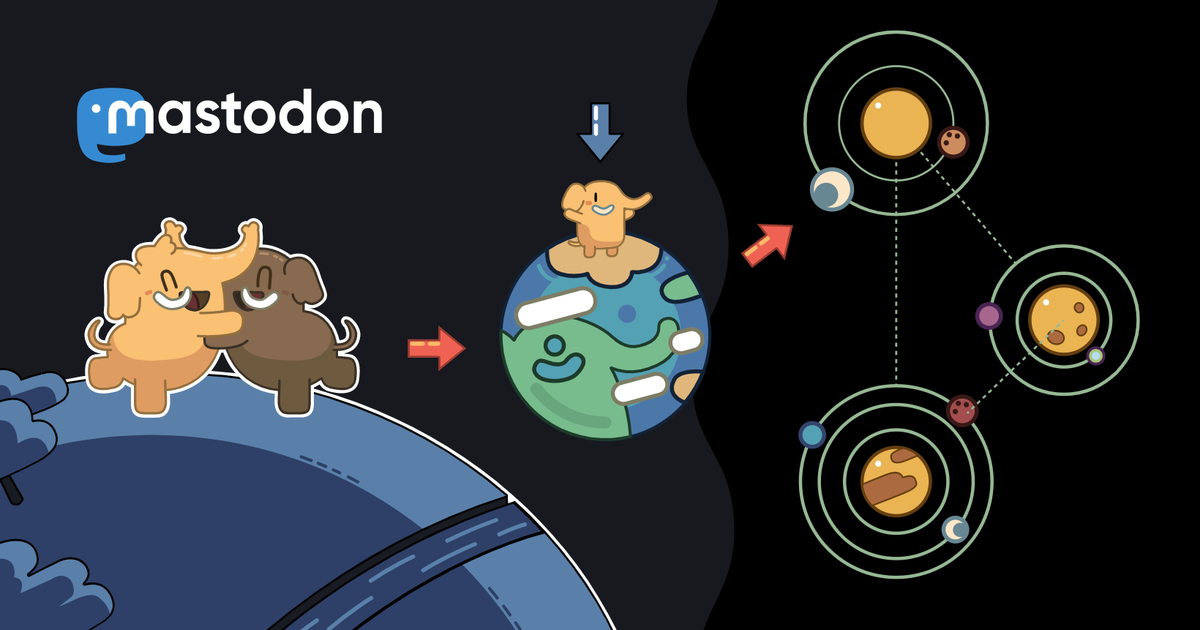Lukas VFN 🇪🇺<p><a href="https://scholar.social/tags/FEMSmicroBlog" class="mention hashtag" rel="nofollow noopener" target="_blank">#<span>FEMSmicroBlog</span></a>: The incredible world of archaeal viruses <br><a href="https://fems-microbiology.org/femsmicroblog-the-incredible-world-of-archaeal-viruses/" rel="nofollow noopener" translate="no" target="_blank"><span class="invisible">https://</span><span class="ellipsis">fems-microbiology.org/femsmicr</span><span class="invisible">oblog-the-incredible-world-of-archaeal-viruses/</span></a></p><p>Review: Archaeal <a href="https://scholar.social/tags/virus" class="mention hashtag" rel="nofollow noopener" target="_blank">#<span>virus</span></a> entry and egress <a href="https://academic.oup.com/microlife/article/doi/10.1093/femsml/uqad048/7505774" rel="nofollow noopener" translate="no" target="_blank"><span class="invisible">https://</span><span class="ellipsis">academic.oup.com/microlife/art</span><span class="invisible">icle/doi/10.1093/femsml/uqad048/7505774</span></a> </p><p>"Archaeal <a href="https://scholar.social/tags/viruses" class="mention hashtag" rel="nofollow noopener" target="_blank">#<span>viruses</span></a> have a broad range of morphologies, with many families showing unique shapes. In comparison to other viruses, most aspects of the infection cycles of viruses of <a href="https://scholar.social/tags/Archaea" class="mention hashtag" rel="nofollow noopener" target="_blank">#<span>Archaea</span></a> and their genomic features remain unexplored."</p>
mstdn.social is one of the many independent Mastodon servers you can use to participate in the fediverse.

A general-purpose Mastodon server with a 500 character limit. All languages are welcome.
Administered by:
Server stats:
6.6Kactive users
mstdn.social: About · Status · Profiles directory · Privacy policy · Terms of service
Mastodon: About · Get the app · Keyboard shortcuts · View source code · v4.4.1
#FEMSmicroBlog
0 posts · 0 participants · 0 posts today
Lukas VFN 🇪🇺<p><a href="https://scholar.social/tags/FEMSmicroBlog" class="mention hashtag" rel="nofollow noopener" target="_blank">#<span>FEMSmicroBlog</span></a>: Mangrove trees in the <a href="https://scholar.social/tags/Caribbean" class="mention hashtag" rel="nofollow noopener" target="_blank">#<span>Caribbean</span></a> as cyanobacterial reservoirs<br><a href="https://fems-microbiology.org/femsmicroblog-mangrove-trees-in-the-caribbean-as-cyanobacterial-reservoirs/" rel="nofollow noopener" translate="no" target="_blank"><span class="invisible">https://</span><span class="ellipsis">fems-microbiology.org/femsmicr</span><span class="invisible">oblog-mangrove-trees-in-the-caribbean-as-cyanobacterial-reservoirs/</span></a></p><p>Genomes of nine <a href="https://scholar.social/tags/biofilm" class="mention hashtag" rel="nofollow noopener" target="_blank">#<span>biofilm</span></a>-forming filamentous strains of <a href="https://scholar.social/tags/Cyanobacteria" class="mention hashtag" rel="nofollow noopener" target="_blank">#<span>Cyanobacteria</span></a> isolated from <a href="https://scholar.social/tags/mangrove" class="mention hashtag" rel="nofollow noopener" target="_blank">#<span>mangrove</span></a> habitats of <a href="https://scholar.social/tags/Guadeloupe" class="mention hashtag" rel="nofollow noopener" target="_blank">#<span>Guadeloupe</span></a> <a href="https://academic.oup.com/femsmicrobes/article/doi/10.1093/femsmc/xtad024/7473707" rel="nofollow noopener" translate="no" target="_blank"><span class="invisible">https://</span><span class="ellipsis">academic.oup.com/femsmicrobes/</span><span class="invisible">article/doi/10.1093/femsmc/xtad024/7473707</span></a> </p><p>"Within each of these genera, strains have variable metabolic abilities. For example, only two of the four Karukerafilum strains contain genes for nitrogen fixation, an ecologically important function in mangrove ecosystems."</p>
Georgy Kurakin<p>I have started contributing to the <a href="https://mastodon.world/tags/MicrobiologyInArt" class="mention hashtag" rel="nofollow noopener" target="_blank">#<span>MicrobiologyInArt</span></a> section of <a href="https://mastodon.world/tags/FEMSmicroBlog" class="mention hashtag" rel="nofollow noopener" target="_blank">#<span>FEMSmicroBlog</span></a> (by FEMS).<br>In my first post, I tried to find out why microbiology comics are so popular now — and why more and more people engage in this area?</p><p>❓ What would be your reaction, if tomorrow you will receive a letter from a journal editorial office requesting to provide a comic abstract for your article?</p><p><a href="https://fems-microbiology.org/femsmicroblog-microbiology-going-comic/" rel="nofollow noopener" translate="no" target="_blank"><span class="invisible">https://</span><span class="ellipsis">fems-microbiology.org/femsmicr</span><span class="invisible">oblog-microbiology-going-comic/</span></a></p>
Lukas VFN 🇪🇺<p>Visualising the soil <a href="https://scholar.social/tags/mycelium" class="mention hashtag" rel="nofollow noopener" target="_blank">#<span>mycelium</span></a> <a href="https://fems-microbiology.org/femsmicroblog-fungal-drops-visualising-the-soil-mycelium/" rel="nofollow noopener" translate="no" target="_blank"><span class="invisible">https://</span><span class="ellipsis">fems-microbiology.org/femsmicr</span><span class="invisible">oblog-fungal-drops-visualising-the-soil-mycelium/</span></a></p><p><a href="https://scholar.social/tags/Fungal" class="mention hashtag" rel="nofollow noopener" target="_blank">#<span>Fungal</span></a> drops: a novel approach for macro- and microscopic analyses of fungal mycelial growth <a href="https://academic.oup.com/microlife/article/doi/10.1093/femsml/uqad042/7321574" rel="nofollow noopener" translate="no" target="_blank"><span class="invisible">https://</span><span class="ellipsis">academic.oup.com/microlife/art</span><span class="invisible">icle/doi/10.1093/femsml/uqad042/7321574</span></a></p><p>"Replicating the three-dimensional heterogeneity of <a href="https://scholar.social/tags/soil" class="mention hashtag" rel="nofollow noopener" target="_blank">#<span>soil</span></a> systems in the laboratory is extremely difficult. The Fungal Drops method addresses this challenge by creating a controlled and heterogeneous two-dimensional environment." </p><p><a href="https://scholar.social/tags/Fungi" class="mention hashtag" rel="nofollow noopener" target="_blank">#<span>Fungi</span></a> <a href="https://scholar.social/tags/Mushrooms" class="mention hashtag" rel="nofollow noopener" target="_blank">#<span>Mushrooms</span></a> <a href="https://scholar.social/tags/FEMSmicroBlog" class="mention hashtag" rel="nofollow noopener" target="_blank">#<span>FEMSmicroBlog</span></a></p>
Lukas VFN 🇪🇺<p>New <a href="https://scholar.social/tags/viruses" class="mention hashtag" rel="nofollow noopener" target="_blank">#<span>viruses</span></a> discovered in 2023 <a href="https://fems-microbiology.org/femsmicroblog-new-viruses-discovered-in-2023/" rel="nofollow noopener" translate="no" target="_blank"><span class="invisible">https://</span><span class="ellipsis">fems-microbiology.org/femsmicr</span><span class="invisible">oblog-new-viruses-discovered-in-2023/</span></a> <a href="https://scholar.social/tags/FEMSmicroBlog" class="mention hashtag" rel="nofollow noopener" target="_blank">#<span>FEMSmicroBlog</span></a> <a href="https://scholar.social/tags/FascinatingMicrobes" class="mention hashtag" rel="nofollow noopener" target="_blank">#<span>FascinatingMicrobes</span></a> <a href="https://scholar.social/tags/Microbes" class="mention hashtag" rel="nofollow noopener" target="_blank">#<span>Microbes</span></a> <a href="https://scholar.social/tags/NewSpecies" class="mention hashtag" rel="nofollow noopener" target="_blank">#<span>NewSpecies</span></a> by dr. Sarah Wettstadt</p>
Lukas VFN 🇪🇺<p>New <a href="https://scholar.social/tags/bacteria" class="mention hashtag" rel="nofollow noopener" target="_blank">#<span>bacteria</span></a> discovered in 2023 <a href="https://fems-microbiology.org/new-bacteria-discovered-in-2023/" rel="nofollow noopener" translate="no" target="_blank"><span class="invisible">https://</span><span class="ellipsis">fems-microbiology.org/new-bact</span><span class="invisible">eria-discovered-in-2023/</span></a></p><p>Dr. Sarah Wettstadt: "As the year 2023 comes to an end, it is again time to look at some new bacterial members of our microbial world. As always, the list has been extensive, making it difficult to choose a few interesting bacteria to present."</p><p><a href="https://scholar.social/tags/NewSpecies" class="mention hashtag" rel="nofollow noopener" target="_blank">#<span>NewSpecies</span></a> <a href="https://scholar.social/tags/Microbes" class="mention hashtag" rel="nofollow noopener" target="_blank">#<span>Microbes</span></a> <a href="https://scholar.social/tags/FEMSmicroBlog" class="mention hashtag" rel="nofollow noopener" target="_blank">#<span>FEMSmicroBlog</span></a> <a href="https://scholar.social/tags/FascinatingMicrobes" class="mention hashtag" rel="nofollow noopener" target="_blank">#<span>FascinatingMicrobes</span></a></p>
Lukas VFN 🇪🇺<p>Seven new fungi discovered in 2022 <a href="https://fems-microbiology.org/femsmicroblog-seven-new-fungi-discovered-in-2022/" rel="nofollow noopener" target="_blank"><span class="invisible">https://</span><span class="ellipsis">fems-microbiology.org/femsmicr</span><span class="invisible">oblog-seven-new-fungi-discovered-in-2022/</span></a> <a href="https://scholar.social/tags/NewSpecies" class="mention hashtag" rel="nofollow noopener" target="_blank">#<span>NewSpecies</span></a> <a href="https://scholar.social/tags/Microbes" class="mention hashtag" rel="nofollow noopener" target="_blank">#<span>Microbes</span></a> <a href="https://scholar.social/tags/Biodiversity" class="mention hashtag" rel="nofollow noopener" target="_blank">#<span>Biodiversity</span></a> </p><p>Often only associated with their seasonal, ephemeral manifestations (<a href="https://scholar.social/tags/mushrooms" class="mention hashtag" rel="nofollow noopener" target="_blank">#<span>mushrooms</span></a>), <a href="https://scholar.social/tags/fungi" class="mention hashtag" rel="nofollow noopener" target="_blank">#<span>fungi</span></a> are in fact an extremely vast and still rather mysterious kingdom. In this <a href="https://scholar.social/tags/FEMSmicroBlog" class="mention hashtag" rel="nofollow noopener" target="_blank">#<span>FEMSmicroBlog</span></a> post, Corrado Nai presents seven new fungi discovered in 2022 – just a minuscule fraction of the astounding fungal <a href="https://scholar.social/tags/diversity" class="mention hashtag" rel="nofollow noopener" target="_blank">#<span>diversity</span></a> out there.</p>
Lukas VFN 🇪🇺<p><a href="https://scholar.social/tags/FEMSmicroBlog" class="mention hashtag" rel="nofollow noopener" target="_blank">#<span>FEMSmicroBlog</span></a>: Five new environmental viruses discovered in 2022 <a href="https://fems-microbiology.org/femsmicroblog-five-new-environmental-viruses-discovered-in-2022/" rel="nofollow noopener" target="_blank"><span class="invisible">https://</span><span class="ellipsis">fems-microbiology.org/femsmicr</span><span class="invisible">oblog-five-new-environmental-viruses-discovered-in-2022/</span></a> <a href="https://scholar.social/tags/FascinatingMicrobes" class="mention hashtag" rel="nofollow noopener" target="_blank">#<span>FascinatingMicrobes</span></a> </p><p><a href="https://scholar.social/tags/Viruses" class="mention hashtag" rel="nofollow noopener" target="_blank">#<span>Viruses</span></a> not only have clinical impacts on us, but they also infect other species, like animals, plants and even unicellular organisms. Sarah Wettstadt highlights a few newly discovered viruses found in the environment in #2022 and what we can learn from them.</p>
Lukas VFN 🇪🇺<p><a href="https://scholar.social/tags/FEMSmicroBlog" class="mention hashtag" rel="nofollow noopener" target="_blank">#<span>FEMSmicroBlog</span></a>: Five new <a href="https://scholar.social/tags/bacteria" class="mention hashtag" rel="nofollow noopener" target="_blank">#<span>bacteria</span></a> discovered in 2022 <a href="https://fems-microbiology.org/femsmicroblog-new-bacteria-discovered-in-2022/" rel="nofollow noopener" target="_blank"><span class="invisible">https://</span><span class="ellipsis">fems-microbiology.org/femsmicr</span><span class="invisible">oblog-new-bacteria-discovered-in-2022/</span></a> <a href="https://scholar.social/tags/FascinatingMicrobes" class="mention hashtag" rel="nofollow noopener" target="_blank">#<span>FascinatingMicrobes</span></a> <a href="https://scholar.social/tags/Microbes" class="mention hashtag" rel="nofollow noopener" target="_blank">#<span>Microbes</span></a> <a href="https://scholar.social/tags/Microbiology" class="mention hashtag" rel="nofollow noopener" target="_blank">#<span>Microbiology</span></a> <a href="https://scholar.social/tags/Bioremediation" class="mention hashtag" rel="nofollow noopener" target="_blank">#<span>Bioremediation</span></a> </p><p>Throughout the year 2022, researchers found many new bacterial species and genera, many of which might have benefits for us or help us tackle some of our environmental problems. Sarah Wettstadt highlights a few bacteria newly discovered in 2022 and what we can learn from them.</p>
TrendingLive feeds
Mastodon is the best way to keep up with what's happening.
Follow anyone across the fediverse and see it all in chronological order. No algorithms, ads, or clickbait in sight.
Create accountLoginDrag & drop to upload